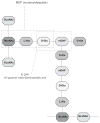TLRs in the Gut I. The role of TLRs/Nods in intestinal development and homeostasis
- PMID: 16844677
- PMCID: PMC3208512
- DOI: 10.1152/ajpgi.00275.2006
TLRs in the Gut I. The role of TLRs/Nods in intestinal development and homeostasis
Abstract
The innate immune system includes microbial pattern recognition receptors that detect bacteria and viral products at the cell surface, in vesicles, and within the cytoplasm. Transmembrane signaling occurs through Toll-like receptors (TLRs). Cytoplasmic receptors are generally members of the nucleotide-binding domain (NOD)-leucine-rich repeat (LRR) family (CATERPILLER family). They influence the effects of other family members and of TLRs. Most NOD-LRR members enhance signal transduction, but Monarch-1 counterbalances TLR activity. NOD-LRR family members also act within the adaptive immune system. The class II transactivator regulates major histocompatibility complex class II expression. In the intestine, it is developmentally regulated, and its expression depends on weaning and, independently, on age.
Figures


References
-
- Agostini L, Martinon F, Burns K, McDermott MF, Hawkins PN, Tschopp J. NALP3 forms an IL-1beta-processing inflammasome with increased activity in Muckle-Wells autoinflammatory disorder. Immunity. 2004;20:319–325. - PubMed
-
- Boughan PK, Argent RH, Body-Malapel M, Park JH, Ewings KE, Bowie AG, Ong SJ, Cook SJ, Sorensen OE, Manzo BA, Inohara N, Klein NJ, Nunez G, Atherton JC, Bajaj-Elliott M. Nucleotide-binding oligomerization domain-1 and epidermal growth factor receptor: critical regulators of beta-defensins during Helicobacter pylori infection. J Biol Chem. 2006;281:11637–11648. - PubMed
-
- Ciftci AO, Tanyel FC, Buyukpamukcu N, Hicsonmez A. Adhesive small bowel obstruction caused by familial Mediterranean fever: the incidence and outcome. J Pediatr Surg. 1995;30:577–579. - PubMed
-
- El-Shanti H, Majeed HA, El-Khateeb M. Familial mediterranean fever in Arabs. Lancet. 2006;367:1016–1024. - PubMed
Publication types
MeSH terms
Substances
Grants and funding
LinkOut - more resources
Full Text Sources

